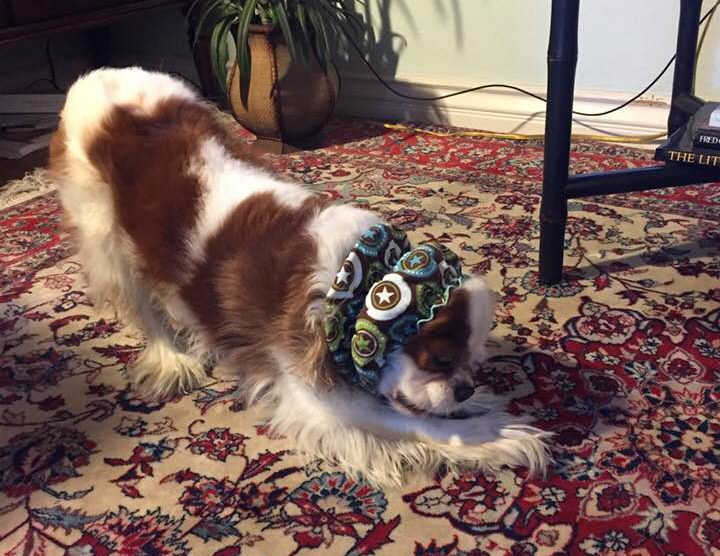The Seek Back is used by police to send a dog to search a large area where a crime may have been committed. A trained dog will search methodically, quartering the area and searching back and forth, the way you might mow a lawn, so they don’t miss a spot.
Once they find something that seems to be out of place, they will not retrieve and deliver the object to their handler. For one thing, the object may be dangerous, a gun or a knife. Also, police would want to see the object where it was found, because there might be other telling information there.
Instead of retrieving the find, the dogs learn to sit and alert, perhaps by turning their head to one side. The dogs do not alert to a daisy, a clump of grass, a bush, but they would alert to a button, a lipstick, a shoe, a torn piece of clothing or, of course, a weapon. A dog or pair of dogs can search infinitely faster than humans. Dogs love the work because they are using their fabulous sense of smell, their intelligence and understanding of the space they are searching, and they are working with a human partner. Those elements translate beautifully into a game.
Since your dog probably doesn’t work for the local police department, we can give him a chance to use the natural talent that allows him to discern something out of place, but we will skip the part about a crime being committed and make a few other changes as well to increase the fun.
Some dogs do a version of the Seek Back naturally. They might bring you any laundry your teenager has left on the floor or retrieve dust-covered pencils from beneath your bed. They might bring your shoes when you are putting on your socks or fetch other items by name. While dogs who love to retrieve will quickly learn the Seek Back as a game, with a bit of patience on your part, any dog can learn and love the game.
Start by teaching your dog “Find It,” which you can do by tossing a handful of kibble on your living room rug or outside on the lawn and saying “Find it, good dog, find it.” Keep encouraging the dog and teaching the words by repeating “Find It” as he runs around looking for kibble and gobbling it up. Once he’s good at this, which won’t take much time at all, seed an area without him watching you – tossing the kibble into your yard, perhaps, and then bringing him out and say “Find it.” Since he will eventually be finding unknown objects, do not show him what he is looking for. Just tell him “Find it.” It’s food. He’s a dog. He will.
Now we will make a quick switch. Unlike police dogs searching a crime scene for something out of place, your dog will be finding something out of place with your scent on it. Take your dog for a walk around your yard or, on leash, on his usual walk. As you go, drop something behind your back as you keep walking. Drop something that doesn’t clunk when it lands so your dog doesn’t notice. If you are in your yard and your dog is off leash, after a few more steps, send him back, pointing in the direction from which you came and saying, “Find it, Good Dog, Find It.” In this game, your dog doesn’t alert, he brings you what he found: a small toy, a glove, a scarf. As soon as he sees the object, begin to praise him and keep it up as you call him to you, praising him like crazy as he gets closer and closer.
If you are out and about, do the same thing but use a longish leash and follow your dog as he retraces your steps to find the object. Once he’s good at this and snorts with delight on his way back, you can get creative with objects for him to find and bring to you. Years ago, when I was out with my Border Collie, Flash, I discovered I had nothing to drop. I opened my wallet, planning on tenting a single dollar bill and dropping that, but the smallest bill I had was a five. I folded the five the long way, kept walking and then dropped it behind me, hoping that, even in New York City, the street would remain empty and no one would come along and scoop up my five before Flash did. Happily, we got lucky. I sent Flash, running behind him holding onto the long leash, and he scooped up the five and pressed it into my hand, sneezing and dancing in delight. The Seek Back as a game is a hands-down favorite of any dog lucky enough to learn and play it. More than likely, it will be a favorite of yours, too.
This article was reviewed/edited by board-certified veterinary behaviorist Dr. Kenneth Martin and/or veterinary technician specialist in behavior Debbie Martin, LVT.








